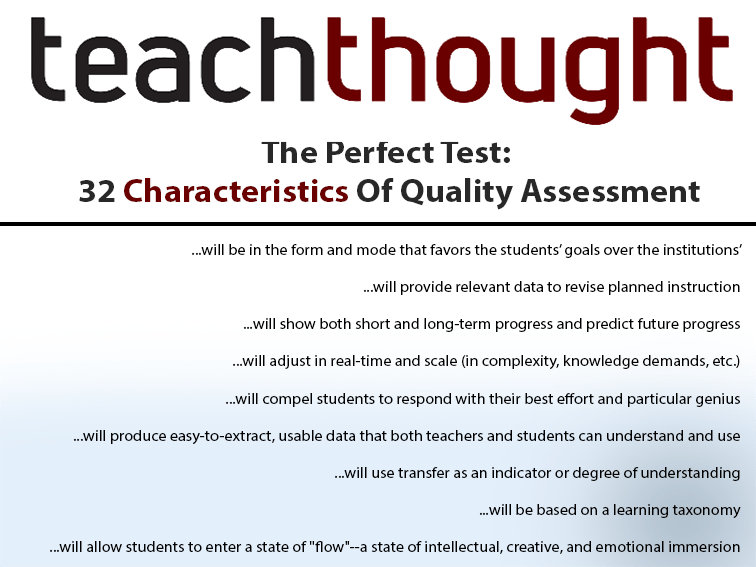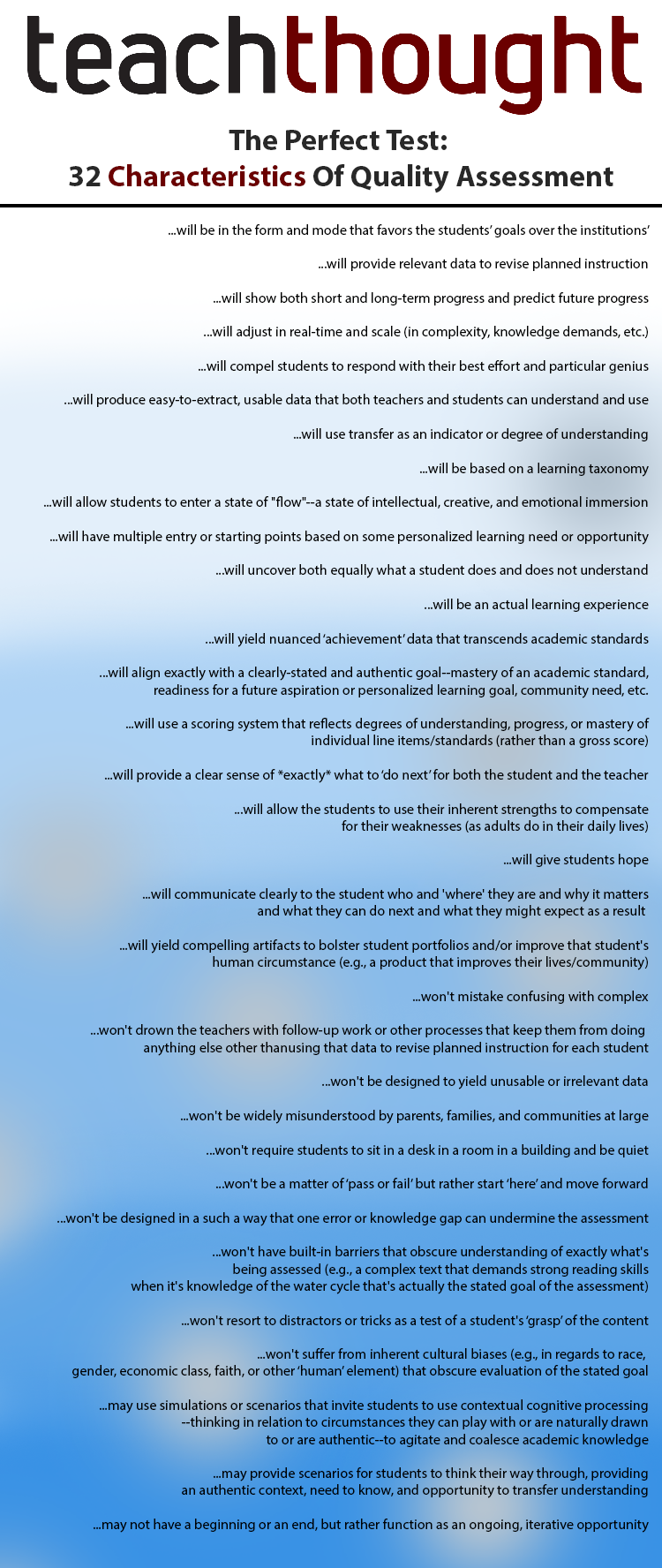
What Are The Characteristics Of Quality Assessment?
by Terry Heick
Nothing is perfect, but we can dream.
So let’s dream about assessment.
First, what is an assessment? A measurement? A snapshot? A kind of bar for students to clear? In The Most Important Question Every Question Should Answer, I theorized that “the benefit of assessments for learning isn’t merely a more clear picture of understanding; used properly, it can also inform the rest of the learning process, from curriculum mapping (what do we learn when?) to instruction (how will it be learned?) to assessment design (how should future learning ideally be measured?)”
If the goal of our collective craft is understanding, then the tools we use should promote understanding, both directly and indirectly. Assessment is one of those tools–one widely misunderstood by teachers, and causing anxiety in the students we’re trying to serve. So then, can we do better with our assessments? I want to think of assessments in a completely different light, especially in light of modern technology. Take a clean sheet design approach to how we think of the word “test” (the patriarch of the assessment family).
So what would the perfect assessment be like? If we can design anything–not just digitize multiple choice questions, but start from scratch? What would the perfect assessment do? How would it be formed? What data would it yield? What effect would it have on the student?
How would it be used to improve learning? How could it serve students–like stairs–instead of being obstacles to clear, like hurdles?
How can it promote understanding without haunting students?
There’s no single answer here because there are too many moving parts. So we can’t hope for perfection, but we can hope for perfect alignment between goals and function: What we want, and how we hope to achieve it. It’s not impossible, then, to begin to identify a set of indicators of a near perfect assessment–what it would and would not do, for starters.
Below, I guess at some of these indicators. I didn’t have a particular assessment form (MC, essay, performance task, project, etc.) or mode (norm-referenced, criterion-based, etc.) in mind. Clean sheet design and all. (You can read more about different types of assessment, or see 10 assessments you can perform in 90 seconds or less as well.)
I was more interested in the function of assessment as a tool for learning, and what we might be missing.

32 Characteristics Of The Perfect Test
- …will be in the form and mode that favors the students’ goals over the institutions’
- …will provide relevant data to revise planned instruction
- …will show both short and long-term progress and predict future progress
- …will adjust in real-time and scale (in complexity, knowledge demands, etc.)
- …will compel students to respond with their best effort and particular genius
- …will produce easy-to-extract, usable data that both teachers and students can understand and use
- …will use transfer as an indicator or degree of understanding
- …will be based on a learning taxonomy
- …will allow students to enter a state of “flow”–a state of intellectual, creative, and emotional immersion
- …will have multiple entry or starting points based on some personalized learning need or opportunity
- …will uncover both equally what a student does and does not understand
- …will be an actual learning experience
- …will yield nuanced ‘achievement’ data that transcends academic standards
- …will align exactly with a clearly-stated and authentic goal–mastery of an academic standard, readiness for a future aspiration or personalized learning goal, community need, etc.
- …will use a scoring system that reflects degrees of understanding, progress, or mastery of individual line items/standards (rather than a gross score)
- …will provide a clear sense of *exactly* what to ‘do next’ for both the student and the teacher
- …will allow the students to use their inherent strengths to compensate for their weaknesses (as adults do in their daily lives)
- …will give students hope
- …will yield compelling artifacts to bolster student portfolios and/or improve that student’s human circumstance (e.g., a product that improves their lives/community)
- …will communicate clearly to the student who and ‘where’ they are and why it matters and what they can do next and what they might expect as a result
- …won’t mistake confusing with complex
- …won’t drown the teachers with follow-up work or other processes that keep them from doing anything else other than using that data to revise planned instruction for each student
- …won’t be designed to yield unusable or irrelevant data
- …won’t be widely misunderstood by parents, families, and communities at large
- …won’t require students to sit in a desk in a room in a building and be quiet
- …won’t be a matter of ‘pass or fail,’ but rather start here and move forward
- …won’t be designed in a such a way that one error or knowledge gap can undermine the assessment
- ..won’t have built-in barriers that obscure understanding of exactly what’s being assessed (e.g., a complex text that demands strong reading skills when it’s knowledge of the water cycle that’s actually the stated goal of the assessment)
- …won’t resort to distractors or tricks as a test of a student’s ‘grasp’ of the content
- …won’t suffer from inherent cultural biases (e.g., in regards to race, gender, economic class, faith, or other ‘human’ element) that obscure evaluation of the stated goal
- …may use simulations or scenarios that invite students to use contextual cognitive processing –thinking in relation to circumstances they can play with or are naturally drawn to or are authentic–to agitate and coalesce academic knowledge
- …may provide scenarios for students to think their way through, providing an authentic context, need to know, and opportunity to transfer understanding
- …may not have a beginning or an end, but rather function as an ongoing, iterative opportunity
